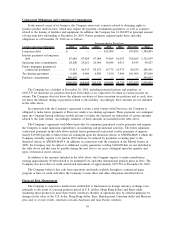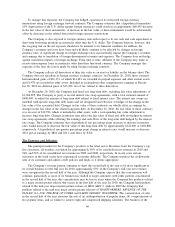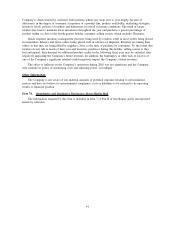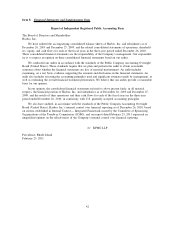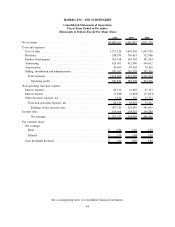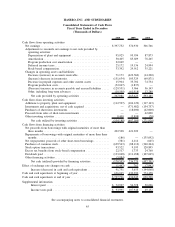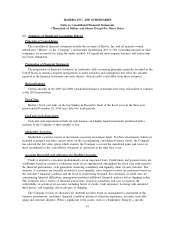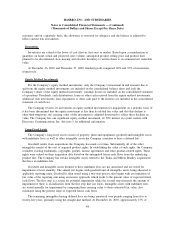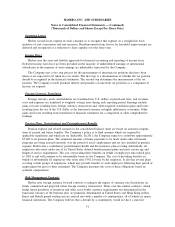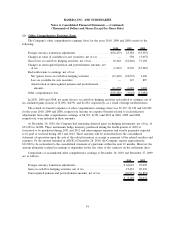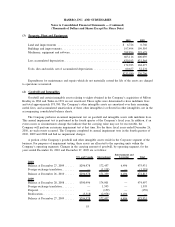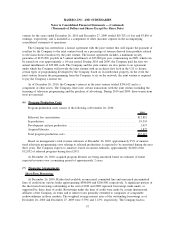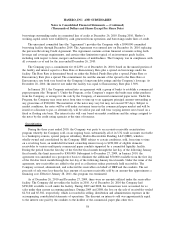Hasbro 2010 Annual Report Download - page 59
Download and view the complete annual report
Please find page 59 of the 2010 Hasbro annual report below. You can navigate through the pages in the report by either clicking on the pages listed below, or by using the keyword search tool below to find specific information within the annual report.
other intangibles relate to rights acquired in connection with a major entertainment property and are being
amortized in proportion to projected sales of the licensed products over the contract life.
Property, plant and equipment are stated at cost less accumulated depreciation. Depreciation is computed
using accelerated and straight-line methods to depreciate the cost of property, plant and equipment over their
estimated useful lives. The principal lives, in years, used in determining depreciation rates of various assets
are: land improvements 15 to 19, buildings and improvements 15 to 25 and machinery and equipment 3 to 12.
Depreciation expense is classified in the statement of operations based on the nature of the property and
equipment being depreciated. Tools, dies and molds are depreciated over a three-year period or their useful
lives, whichever is less, using an accelerated method. The Company generally owns all tools, dies and molds
related to its products.
The Company reviews property, plant and equipment and other intangibles with defined lives for
impairment whenever events or changes in circumstances indicate the carrying value may not be recoverable.
Recoverability is measured by a comparison of the carrying amount of an asset or asset group to future
undiscounted cash flows expected to be generated by the asset or asset group. If such assets were considered
to be impaired, the impairment to be recognized would be measured by the amount by which the carrying
value of the assets exceeds their fair value. Fair value is determined based on discounted cash flows or
appraised values, depending on the nature of the assets. Assets to be disposed of are carried at the lower of the
net book value or their estimated fair value less disposal costs.
Financial Instruments
Hasbro’s financial instruments include cash and cash equivalents, accounts receivable, short-term borrow-
ings, accounts payable and accrued liabilities. At December 26, 2010, the carrying cost of these instruments
approximated their fair value. The Company’s financial instruments at December 26, 2010 also include long-
term borrowings (see note 9 for carrying cost and related fair values) as well as certain assets and liabilities
measured at fair value (see notes 9, 12 and 16).
Securitization and Transfer of Financial Instruments
During the three years ended 2010, Hasbro had an agreement that allowed the Company to sell, on an
ongoing basis, an undivided fractional ownership interest in certain of its trade accounts receivable through a
revolving securitization arrangement. The Company retained servicing responsibilities for, as well as a
subordinate interest in, the transferred receivables. In 2009 and prior, Hasbro accounted for the securitization
of trade accounts receivable as a sale in accordance with then current accounting standards. As a result, the
related receivables were removed from the consolidated balance sheet.
In 2010, the Company adopted the revised accounting standards related to the transfer of financial assets.
As a result of the adoption of these standards, the Company was required to account for the sale of the
receivables under the securitization facility as a secured borrowing. The receivables sold are included in
accounts receivable until collection. The proceeds from utilization of the facility are recorded as short-term
debt. The Company did not utilize this facility in 2010. The facility was terminated effective January 28,
2011.
Revenue Recognition
Revenue from product sales is recognized upon the passing of title to the customer, generally at the time
of shipment. Provisions for discounts, rebates and returns are made when the related revenues are recognized.
The Company bases its estimates for discounts, rebates and returns on agreed customer terms and historical
experience.
49
HASBRO, INC. AND SUBSIDIARIES
Notes to Consolidated Financial Statements — (Continued)
(Thousands of Dollars and Shares Except Per Share Data)


